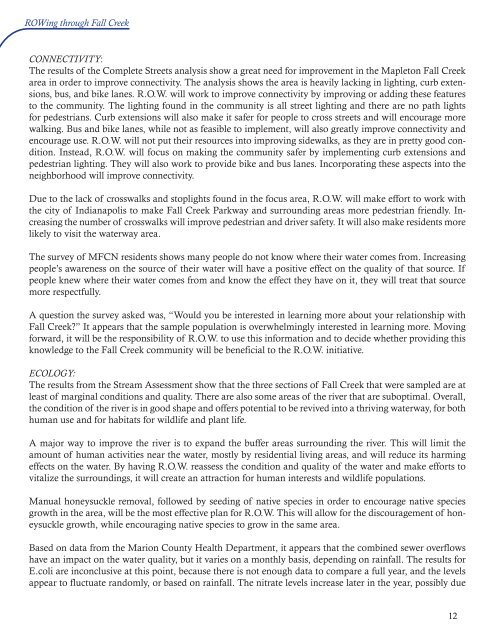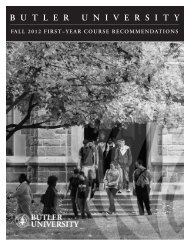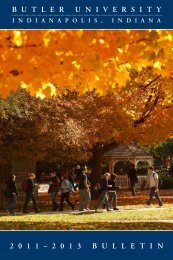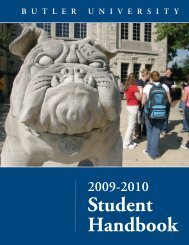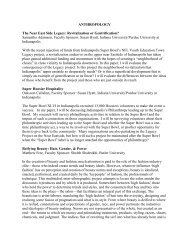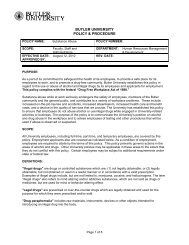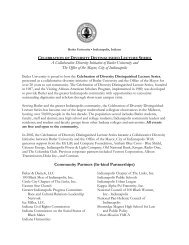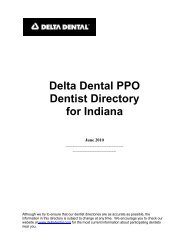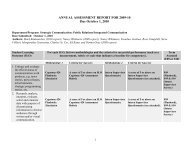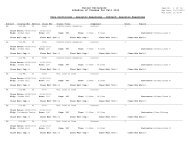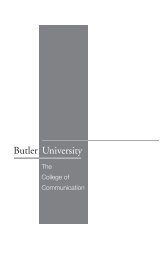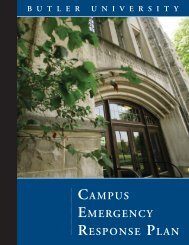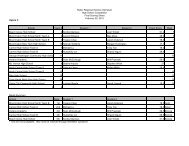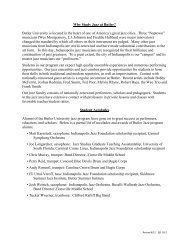ROWing Through Fall Creek - Butler University
ROWing Through Fall Creek - Butler University
ROWing Through Fall Creek - Butler University
Create successful ePaper yourself
Turn your PDF publications into a flip-book with our unique Google optimized e-Paper software.
<strong>ROWing</strong> through <strong>Fall</strong> <strong>Creek</strong><br />
CONNECTIVITY:<br />
The results of the Complete Streets analysis show a great need for improvement in the Mapleton <strong>Fall</strong> <strong>Creek</strong><br />
area in order to improve connectivity. The analysis shows the area is heavily lacking in lighting, curb extensions,<br />
bus, and bike lanes. R.O.W. will work to improve connectivity by improving or adding these features<br />
to the community. The lighting found in the community is all street lighting and there are no path lights<br />
for pedestrians. Curb extensions will also make it safer for people to cross streets and will encourage more<br />
walking. Bus and bike lanes, while not as feasible to implement, will also greatly improve connectivity and<br />
encourage use. R.O.W. will not put their resources into improving sidewalks, as they are in pretty good condition.<br />
Instead, R.O.W. will focus on making the community safer by implementing curb extensions and<br />
pedestrian lighting. They will also work to provide bike and bus lanes. Incorporating these aspects into the<br />
neighborhood will improve connectivity.<br />
Due to the lack of crosswalks and stoplights found in the focus area, R.O.W. will make effort to work with<br />
the city of Indianapolis to make <strong>Fall</strong> <strong>Creek</strong> Parkway and surrounding areas more pedestrian friendly. Increasing<br />
the number of crosswalks will improve pedestrian and driver safety. It will also make residents more<br />
likely to visit the waterway area.<br />
The survey of MFCN residents shows many people do not know where their water comes from. Increasing<br />
people’s awareness on the source of their water will have a positive effect on the quality of that source. If<br />
people knew where their water comes from and know the effect they have on it, they will treat that source<br />
more respectfully.<br />
A question the survey asked was, “Would you be interested in learning more about your relationship with<br />
<strong>Fall</strong> <strong>Creek</strong>?” It appears that the sample population is overwhelmingly interested in learning more. Moving<br />
forward, it will be the responsibility of R.O.W. to use this information and to decide whether providing this<br />
knowledge to the <strong>Fall</strong> <strong>Creek</strong> community will be beneficial to the R.O.W. initiative.<br />
ECOLOGY:<br />
The results from the Stream Assessment show that the three sections of <strong>Fall</strong> <strong>Creek</strong> that were sampled are at<br />
least of marginal conditions and quality. There are also some areas of the river that are suboptimal. Overall,<br />
the condition of the river is in good shape and offers potential to be revived into a thriving waterway, for both<br />
human use and for habitats for wildlife and plant life.<br />
A major way to improve the river is to expand the buffer areas surrounding the river. This will limit the<br />
amount of human activities near the water, mostly by residential living areas, and will reduce its harming<br />
effects on the water. By having R.O.W. reassess the condition and quality of the water and make efforts to<br />
vitalize the surroundings, it will create an attraction for human interests and wildlife populations.<br />
Manual honeysuckle removal, followed by seeding of native species in order to encourage native species<br />
growth in the area, will be the most effective plan for R.O.W. This will allow for the discouragement of honeysuckle<br />
growth, while encouraging native species to grow in the same area.<br />
Based on data from the Marion County Health Department, it appears that the combined sewer overflows<br />
have an impact on the water quality, but it varies on a monthly basis, depending on rainfall. The results for<br />
E.coli are inconclusive at this point, because there is not enough data to compare a full year, and the levels<br />
appear to fluctuate randomly, or based on rainfall. The nitrate levels increase later in the year, possibly due<br />
12


